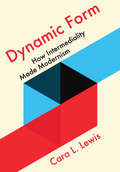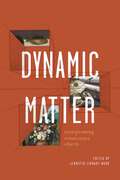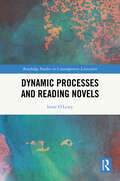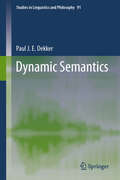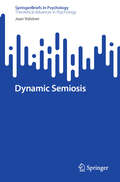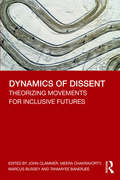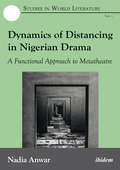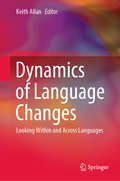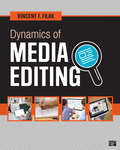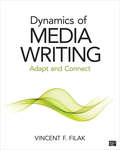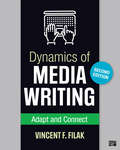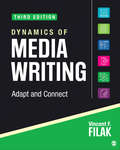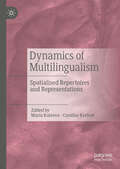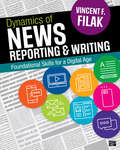- Table View
- List View
Dynamic Ecologies
by Neil Murray Angela ScarinoThis volume provides a fascinating glimpse into the complex language ecologies of Southeast Asia. Adopting a relational perspective, it considers their significance for the region, its peoples, the policy and practice of language teaching, learning and assessment and the fate of local languages. It gives particular prominence to the relationship between English and Chinese, it's likely transformation at a time of significant global change and the impact that these two languages and their synergy will have on the place of other languages and dialects. Dynamic Ecologies: A Relational Perspective on Languages Education in the Asia-Pacific Region draws on the research and insights of key scholars in the field and provides case studies that illustrate the impact of relevant language policy in countries including Singapore, Malaysia, Hong Kong, South Korea and Australia.
Dynamic Fair Dealing
by Martin Zeilinger Rosemary Coombe Darren WershlerDynamic Fair Dealing argues that only a dynamic, flexible, and equitable approach to cultural ownership can accommodate the astonishing range of ways that we create, circulate, manage, attribute, and make use of digital cultural objects.The Canadian legal tradition strives to balance the rights of copyright holders with public needs to engage with copyright protected material, but there is now a substantial gap between what people actually do with cultural forms and how the law understands those practices. Digital technologies continue to shape new forms of cultural production, circulation, and distribution that challenge both the practicality and the desirability of Canada's fair dealing provisions.Dynamic Fair Dealing presents a range of insightful and provocative essays that rethink our relationship to Canadian fair dealing policy. With contributions from scholars, activists, and artists from across disciplines, professions, and creative practices, this book explores the extent to which copyright has expanded into every facet of society and reveals how our capacities to actually deal fairly with cultural goods has suffered in the process. In order to drive conversations about the cultural worlds Canadians imagine, and the policy reforms we need to realize these visions, we need Dynamic Fair Dealing.
Dynamic Form: How Intermediality Made Modernism
by Cara L. LewisDynamic Form traces how intermedial experiments shape modernist texts from 1900 to 1950. Considering literature alongside painting, sculpture, photography, and film, Cara Lewis examines how these arts inflect narrative movement, contribute to plot events, and configure poetry and memoir. As forms and formal theories cross from one artistic realm to another and back again, modernism shows its obsession with form—and even at times becomes a formalism itself—but as Lewis writes, that form is far more dynamic than we have given it credit for. Form fulfills such various functions that we cannot characterize it as a mere container for content or matter, nor can we consign it to ignominy opposite historicism or political commitment.As a structure or scheme that enables action, form in modernism can be plastic, protean, or even fragile, and works by Henry James, Virginia Woolf, Mina Loy, Evelyn Waugh, and Gertrude Stein demonstrate the range of form's operations. Revising three major formal paradigms—spatial form, pure form, and formlessness—and recasting the history of modernist form, this book proposes an understanding of form as a verbal category, as a kind of doing. Dynamic Form thus opens new possibilities for conversation between modernist studies and formalist studies and simultaneously promotes a capacious rethinking of the convergence between literary modernism and creative work in other media.
Dynamic Matter: Transforming Renaissance Objects (Cultural Inquiries in English Literature, 1400–1700)
by Jennifer Linhart WoodDynamic Matter investigates the life histories of Renaissance objects. Eschewing the critical tendency to study how objects relate to human needs and desires, this work foregrounds the objects themselves, demonstrating their potential to transform their environments as they travel across time and space.Integrating early modern material theories with recent critical approaches in Actor-Network Theory and object-oriented ontology, this volume extends Aristotle’s theory of dynameos—which conceptualizes matter as potentiality—and applies it to objects featured in early modern texts such as Edmund Spenser’s The Faerie Queene, Robert Hooke’s Micrographia, and William Shakespeare’s The Tempest. Individual chapters explore the dynameos of matter by examining its manifestations in particular forms: combs are inscribed with words and brushed through human hair; feathers are incorporated into garments and artwork; Prince Rupert’s glasswork drops explode; a whale becomes animated by the power of a magical bracelet; and books are drowned. These case studies highlight the potentiality matter itself possesses and that which it activates in other matter. A theorization of objects grounded in Renaissance materialist thought, Dynamic Matter examines the richness of things themselves; the larger, multiple, and changing networks in which things circulate; and the networks created by these transformative objects.In addition to the editor, the contributors to this volume include Anna Riehl Bertolet, Erika Mary Boeckeler, Naomi Howell, Emily E. F. Philbrick, Josie Schoel, Maria Shmygol, Edward McLean Test, Abbie Weinberg, and Sarah F. Williams.
Dynamic Processes and Reading Novels (Routledge Studies in Contemporary Literature)
by Irene O’LearyThis book is about the dynamic processes that generate novel-reading. It takes the view that the world is composed of dynamic processes and introduces a process dynamics approach to articulate this stance. This fresh perspective draws on literary studies, process philosophy and neuroscience to argue that dynamic literary and microcognitive processes constantly reconfigure the conditions that they co-create during reading. Analyses of The PowerBook by Jeanette Winterson, The Curious Incident of the Dog in the Night-time by Mark Haddon and Oryx and Crake by Margaret Atwood consider style, narration, allusion and creativity in interaction with diverse microcognitive processes involved in reading. The analyses are strengthened by taking live action into account, illuminating changes that many critical perspectives miss or standardise and avoiding reliance on illusory ideal readers and readings. In proposing a process approach to dynamics and its analysis, this book paves the way for new research across disciplines.
Dynamic Semantics
by Paul J.E. DekkerThe integrated theory of dynamic interpretation set out here will be a surprise to advanced researchers in linguistics. It combines classical formal semantics and modern dynamic semantics without altering the fundamental paradigm. At the book's core lies a pragmatically motivated notion of a dynamic conjunction of meanings, an idea that is worked out in full formal detail. This is applied to linguistic phenomena that involve anaphora, quantification and modality. The author demonstrates that in each area of application existing data can be neatly combined with new dynamic insights, but more importantly, there is a genuine further pay-off: the work generates treatments of phenomena that were not initially intended, with functional readings of pronouns and quantifiers, 'Hob-Nob' sentences, and insights into what we now call 'Pierce's Puzzle'. The outcome of a decade of work by the Amsterdam School of dynamic semantics, this volume condenses and reflects upon a vital body of research.
Dynamic Semiosis (SpringerBriefs in Psychology)
by Jaan ValsinerThis book aims to bring to readers the author’s elaborated focus on the dynamic process of sign emergence, use, fixation and un-fixation, and dismissal. Its uniqueness is in its reliance on the organizing limits of irreversible time that renders the meaning construction by human beings to be constantly open-ended to face the uncertainties of the immediate future. This book emerged from a 9-month series of seminars at the Department of Semiotics at Tartu University in 2021-2022 as a Välis-Eesti Külalisprofessor, during which the linkages between semiotics and cultural psychology were scrutinized. In collaboration with doctoral students from various countries, the present SpringerBrief outlines the theoretical innovations that the author started during the seminars but completed in the two years after their end.
Dynamics and Performativity of Imagination: The Image between the Visible and the Invisible (Routledge Research In Cultural And Media Studies #21)
by Christoph Wulf Bernd HuppaufIn this interdisciplinary anthology, essays study the relationship between the imagination and images both material and mental. Through case studies on a diverse array of topics including photography, film, sports, theater, and anthropology, contributors focus on the role of the creative imagination in seeing and producing images and the imaginary.
Dynamics of Dissent: Theorizing Movements for Inclusive Futures
by John Clammer Meera Chakravorty Marcus Bussey Tanmayee BanerjeeThis book analyses dissent and its manifestations in movements of social and political transformation across communities and cultures. It shows how these movements create ruptures in the structures of power, and social hierarchy; expressed through songs, slogans, poetry and performances. The chapters in the book explore these sites of transgression and the imprint they leave on culture, politics, beliefs and the collective society – via music and poetry as in the Bhakti movement or through feministic theories born in post-World War Europe. It also explores how these dynamic movements generate alternate spaces within which the self, identity and collective purpose take new forms and find new meanings as they travel. This book will be of interest to students and scholars of the humanities, literature, history, sociology, politics and culture studies.
Dynamics of Distancing in Nigerian Drama: A Functional Approach to Metatheatre (Studies in World Literature #1)
by Nadia AnwarNadia Anwar analyzes select post-independence Nigerian dramas through the conceptual framework of metatheater, a strategy that breaks dramatic illusion to foreground the process of play making. Anwar argues that distancing, as a function of metatheater, fosters a balanced theatrical environment by allowing the emotive and cognitive aspects of reception to dominate the theatergoing experience. She draws on Bertolt Brecht, Thomas J. Scheff, and other theoreticians to critique plays by Wole Soyinka, Ola Rotimi, Femi Osofisan, Esiaba Irobi, and Stella 'Dia Oyedepo.
Dynamics of Emigration: Émigré Scholars and the Production of Historical Knowledge in the 20th Century (Making Sense of History #43)
by Stefan Berger and Philipp MüllerAs a pioneering volume to consider the impact of exile on historical scholarship in the twentieth century in a systematic and global way, looking at Europe, North America, South America and Asia, Dynamics of Emigration asks about epistemic repercussions on the experience of exile and exiles. Analyzing both the impact that exile scholars had on their host societies and on the societies they had to leave, the volume investigates exiles’ pathways to integration into new host societies and the many difficulties they face establishing themselves in new surroundings. Focusing on the age of extremes and the realms of exile from fascist and right-wing dictatorships as well as communist regimes, the contributions look at the reasons scholars have for going into exile while providing side-by-side examination of the support organizations and paths for success involved with living in exile.
Dynamics of Language Changes: Looking Within and Across Languages
by Keith AllanThis book explores the dynamics of language changes from sociolinguistic and historical linguistic perspectives. With in-depth case studies from all around the world, it uses diverse approaches across sociolinguistics and historical linguistics to answer questions such as: How and why do language changes begin?; how do language changes spread?; and how can they ultimately be explained?Each chapter explores a different component of language change, including typology, syntax, morphology, phonology, semantics, lexicology, discourse strategies, diachronic change, synchronic change, how the deafblind modify sign language, and the accommodation of language to song. This book presents a comprehensive analysis of the dynamics of language change over time, simultaneously advancing current research and suggesting new directions in sociolinguistic and historical linguistic approaches.
Dynamics of Media Editing
by Vincent F. FilakAs traditional newsrooms staffed by journalists and managed by experienced editors become less and less common, there is an even greater need for all types of professional writers to be fluent in the editorial process. Dynamics of Media Editing emphasizes the broad value of editing as both a tool for journalistic management and an essential skill for individual writers of all stripes. Author Vince F. Filak recognizes editing as an essential process for improving the quality of published writing, something that is relevant and essential to investigative journalists, social media interns, celebrity bloggers, and everyone in between. By organizing the book around skills and by platforms, Dynamics of Media Editing shows students how the basic principles of good editing work across disciplines and media platforms. Key Features The emphasis on transferrable skills and multiple platforms shows students how to use the basic principles of good editing for journalism, PR, advertising, or social media marketing. The book takes a broad approach to editing, demonstrating that it’s not just a skill for managers at newspapers, but rather an essential process for improving all aspects of published writing. This addresses a critical course challenge, in that many students don’t see the relevance of editing in their planned careers. The audience-centric method emphasizes the need to engage one’s audience in order to be a successful writer. "Helpful Hints" boxes provide easy-to-consult lists of dos and don’ts for good writing. "Thoughts From a Pro" boxes allow media professionals from a variety of backgrounds to demonstrate the essential function of the editing process in the workplace.
Dynamics of Media Editing
by Vincent F. FilakAs traditional newsrooms staffed by journalists and managed by experienced editors become less and less common, there is an even greater need for all types of professional writers to be fluent in the editorial process. Dynamics of Media Editing emphasizes the broad value of editing as both a tool for journalistic management and an essential skill for individual writers of all stripes. Author Vince F. Filak recognizes editing as an essential process for improving the quality of published writing, something that is relevant and essential to investigative journalists, social media interns, celebrity bloggers, and everyone in between. By organizing the book around skills and by platforms, Dynamics of Media Editing shows students how the basic principles of good editing work across disciplines and media platforms. Key Features The emphasis on transferrable skills and multiple platforms shows students how to use the basic principles of good editing for journalism, PR, advertising, or social media marketing. The book takes a broad approach to editing, demonstrating that it’s not just a skill for managers at newspapers, but rather an essential process for improving all aspects of published writing. This addresses a critical course challenge, in that many students don’t see the relevance of editing in their planned careers. The audience-centric method emphasizes the need to engage one’s audience in order to be a successful writer. "Helpful Hints" boxes provide easy-to-consult lists of dos and don’ts for good writing. "Thoughts From a Pro" boxes allow media professionals from a variety of backgrounds to demonstrate the essential function of the editing process in the workplace.
Dynamics of Media Writing: Adapt and Connect
by Vincent F. FilakDynamics of Media Writing gives students transferable skills that can be applied across all media platforms—from traditional mass media formats like news, public relations, and advertising to emerging digital media platforms. Whether issuing a press release or tweeting about a new app, today’s media writers need to adapt their message for each specific media format in order to successfully connect with their audience. Throughout this text, award-winning teacher and college media adviser Vincent F. Filak introduces fundamental writing skills that apply to all media, while also highlighting which writing tools and techniques are most effective for specific media formats and why. User-friendly and loaded with practical examples and tips from professionals across mass media, this is the perfect guide for any student wanting to launch a professional media writing career.
Dynamics of Media Writing: Adapt and Connect
by Vincent F. FilakDynamics of Media Writing gives students transferable skills that can be applied across all media platforms—from traditional mass media formats like news, public relations, and advertising to emerging digital media platforms. Whether issuing a press release or tweeting about a new app, today’s media writers need to adapt their message for each specific media format in order to successfully connect with their audience. Throughout this text, award-winning teacher and college media adviser Vincent F. Filak introduces fundamental writing skills that apply to all media, while also highlighting which writing tools and techniques are most effective for specific media formats and why. User-friendly and loaded with practical examples and tips from professionals across mass media, this is the perfect guide for any student wanting to launch a professional media writing career.
Dynamics of Media Writing: Adapt and Connect
by Vincent F. FilakThis fully updated Second Edition of Dynamics of Media Writing helps you learn transferable skills that can be applied across all media platforms—from traditional mass media formats like news, public relations and advertising, to digital and social media platforms. Whether writing a story, press release or a tweet, today’s media writers must adapt their message to each specific media format in order to successfully connect with their audience. New to the Second Edition: A new chapter on social media discusses the latest developments in this rapidly changing area. New Helpful Hints boxes help you hone your media writing skills. New and updated information on interviewing, dictionary usage, lead structure and more bring the book fully up-to-date. Themes from the former Chapter 14 are now woven through the book to stress the importance of clarity and accuracy, lifelong learning and transferable skills. Fake news is now covered in multiple sections to help you both understand and spot it when reviewing the news. Additional photos and graphics illustrate the various elements of storytelling to make the information easier for you to apply. New "Give It a Try" features at the end of the Adapt and Connect boxes allow you to try out the skills outlined.
Dynamics of Media Writing: Adapt and Connect
by Vincent F. FilakThis fully updated Second Edition of Dynamics of Media Writing helps you learn transferable skills that can be applied across all media platforms—from traditional mass media formats like news, public relations and advertising, to digital and social media platforms. Whether writing a story, press release or a tweet, today’s media writers must adapt their message to each specific media format in order to successfully connect with their audience. New to the Second Edition: A new chapter on social media discusses the latest developments in this rapidly changing area. New Helpful Hints boxes help you hone your media writing skills. New and updated information on interviewing, dictionary usage, lead structure and more bring the book fully up-to-date. Themes from the former Chapter 14 are now woven through the book to stress the importance of clarity and accuracy, lifelong learning and transferable skills. Fake news is now covered in multiple sections to help you both understand and spot it when reviewing the news. Additional photos and graphics illustrate the various elements of storytelling to make the information easier for you to apply. New "Give It a Try" features at the end of the Adapt and Connect boxes allow you to try out the skills outlined.
Dynamics of Media Writing: Adapt and Connect
by Vincent F. FilakDynamics of Media Writing Third Edition gives students transferable skills that can be applied across all media platforms—from traditional mass media formats like news, public relations, and advertising to emerging digital media platforms. Whether issuing a press release or tweeting about a new app, today’s media writers need to adapt their message for each specific media format in order to successfully connect with their audience. Throughout this text, award-winning teacher and college media adviser Vincent F. Filak introduces fundamental writing skills that apply to all media, while also highlighting which writing tools and techniques are most effective for specific media formats and why. User-friendly and loaded with practical examples and tips from professionals across mass media, this is the perfect guide for any student wanting to launch a professional media writing career.
Dynamics of Media Writing: Adapt and Connect
by Vincent F. FilakDynamics of Media Writing Third Edition gives students transferable skills that can be applied across all media platforms—from traditional mass media formats like news, public relations, and advertising to emerging digital media platforms. Whether issuing a press release or tweeting about a new app, today’s media writers need to adapt their message for each specific media format in order to successfully connect with their audience. Throughout this text, award-winning teacher and college media adviser Vincent F. Filak introduces fundamental writing skills that apply to all media, while also highlighting which writing tools and techniques are most effective for specific media formats and why. User-friendly and loaded with practical examples and tips from professionals across mass media, this is the perfect guide for any student wanting to launch a professional media writing career.
Dynamics of Media Writing: Adapt and Connect
by Vincent F. FilakDynamics of Media Writing gives students transferable skills that can be applied across all media platforms—from traditional mass media formats like news, public relations, and advertising to emerging digital media platforms. Whether issuing a press release or tweeting about a new app, today’s media writers need to adapt their message for each specific media format in order to successfully connect with their audience. Throughout this text, author Vincent F. Filak introduces fundamental writing skills that apply to all media, while also highlighting which writing tools and techniques are most effective for specific media formats and why. User-friendly and loaded with practical examples and tips from professionals across mass media, this is the perfect guide for any student wanting to launch a professional media writing career. The newly revised Fourth Edition features a new chapter centered around artificial intelligence (AI), in addition to highlighting recent developments in writing for websites and blogs, new interviews with working journalists on recent changes in the industry, and updated examples to show success digital media writing strategies.
Dynamics of Media Writing: Adapt and Connect
by Vincent F. FilakDynamics of Media Writing gives students transferable skills that can be applied across all media platforms—from traditional mass media formats like news, public relations, and advertising to emerging digital media platforms. Whether issuing a press release or tweeting about a new app, today’s media writers need to adapt their message for each specific media format in order to successfully connect with their audience. Throughout this text, author Vincent F. Filak introduces fundamental writing skills that apply to all media, while also highlighting which writing tools and techniques are most effective for specific media formats and why. User-friendly and loaded with practical examples and tips from professionals across mass media, this is the perfect guide for any student wanting to launch a professional media writing career. The newly revised Fourth Edition features a new chapter centered around artificial intelligence (AI), in addition to highlighting recent developments in writing for websites and blogs, new interviews with working journalists on recent changes in the industry, and updated examples to show success digital media writing strategies.
Dynamics of Multilingualism: Spatialised Repertoires and Representations
by Caroline Kerfoot Maria KuteevaThis edited book focuses on the ways in which contemporary societal challenges are constructed, mediated and lived through language and other semiotic modalities in new on- and off-line spaces. It conceives of linguistic repertoires as part of dynamic assemblages that can enable an understanding of the ways in which different bodies, lived experiences, discourses, semiotic resources, and objects intra-act, change and ‘become’ together in unpredictable ways. The chapters reveal the conditions under which such assemblages occur and the nature of the entangled elements that enable certain practices to emerge and then either to endure or disappear, drawing on a range of critical sociolinguistic and discourse analytical methods to explore how histories, languages, bodies, and the material realisation of each space intra-act in the production of determinations of (linguistic) legitimacy and worth, shaping contemporary ideologies of belonging and, thereby, other possibilities. This book will be of interest to students and researchers in fields including sociolinguistics, anthropology, migration studies, and education.
Dynamics of News Reporting and Writing: Foundational Skills for a Digital Age
by Vincent F. FilakJournalists in today’s media environment require a skill set that can be adapted to a variety of media. Dynamics of News Reporting and Writing: Foundational Skills for a Digital Age teaches students the foundational skills they need to successfully report and write the news in an evolving digital landscape. Author Vince F. Filak offers guidance on the essential skills of the industry while weaving in the “how-to’s” of writing digital news. Recognizing that well-crafted stories are founded on sharp prose, this new text covers the foundational elements of newswriting, such as lead writing, structure, and storytelling while also teaching students how to think critically and determine what matters most to their readers. Key Features: An audience-centric approach encourages students to understand why and how news is relevant to the lives of their readers before they even start digging into their stories. “Write Now! Exercises” provide students with an opportunity to immediately practice the core set of skills they have just learned and apply these skills to various platforms. “Consider This” debates spark classroom discussions by encouraging students to take a closer look at a current issue or ideological dilemma and make a valid case for their position. “Thoughts from a Pro” offer students an up-close look at a specific aspect of reporting and writing from a professional who is plying their trade each day.
Dynamics of News Reporting and Writing: Foundational Skills for a Digital Age
by Vincent F. FilakJournalists in today’s media environment require a skill set that can be adapted to a variety of media. Dynamics of News Reporting and Writing: Foundational Skills for a Digital Age teaches students the foundational skills they need to successfully report and write the news in an evolving digital landscape. Author Vince F. Filak offers guidance on the essential skills of the industry while weaving in the “how-to’s” of writing digital news. Recognizing that well-crafted stories are founded on sharp prose, this new text covers the foundational elements of newswriting, such as lead writing, structure, and storytelling while also teaching students how to think critically and determine what matters most to their readers. Key Features: An audience-centric approach encourages students to understand why and how news is relevant to the lives of their readers before they even start digging into their stories. “Write Now! Exercises” provide students with an opportunity to immediately practice the core set of skills they have just learned and apply these skills to various platforms. “Consider This” debates spark classroom discussions by encouraging students to take a closer look at a current issue or ideological dilemma and make a valid case for their position. “Thoughts from a Pro” offer students an up-close look at a specific aspect of reporting and writing from a professional who is plying their trade each day.


